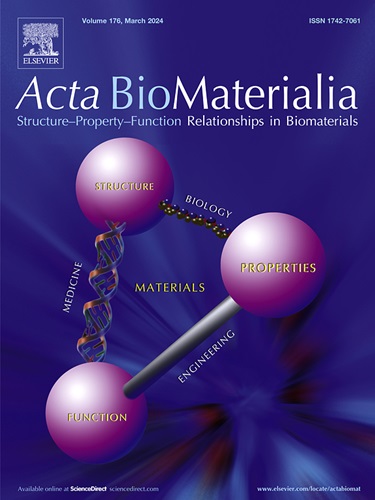冲击吸收头盔设计灵感来自核桃纹理反应扩散机制。
IF 9.4
1区 医学
Q1 ENGINEERING, BIOMEDICAL
引用次数: 0
摘要
核桃壳表面的复杂纹理对提高核桃壳的耐撞性能起着至关重要的作用。尽管在破译它们的功能和形成方面存在挑战,但我们发现这些纹理可以用反应扩散方程来描述。这些方程捕捉了壳的硬化机制,并根据观察到的木质素扩散模式模拟了结构的形成。利用卷积神经网络分类模型对不同局部采样位置和范围的纹理样本集进行分析,确定最具代表性的纹理类。控制方程的参数组合,结合冲击风险评估和个性化需求,为防护头盔的设计提供了信息。物理和数值测试证实了头盔的冲击吸收能力。这些见解为开发抗冲击设备铺平了道路,例如汽车零部件的生物装甲和外壳。意义声明:本研究探讨了核桃壳的复杂纹理,这对提高耐撞性能起着至关重要的作用。我们发现这些织构可以用反应扩散方程来描述,该方程捕捉了壳硬化机制,并基于观察到的木质素扩散模式模拟了织构的形成。利用卷积神经网络分类模型对纹理进行分析,确定最具代表性的纹理类。控制方程的参数组合,结合冲击风险评估和个性化需求,为防护头盔的设计提供了信息。物理和数值测试证实了头盔的冲击吸收能力。这些见解为开发抗冲击设备铺平了道路,例如汽车零部件的生物装甲和外壳。本文章由计算机程序翻译,如有差异,请以英文原文为准。

Impact-absorbing helmet design inspired by walnut texture reaction-diffusion mechanisms
This study investigates the complex textures on walnut shells, which play a vital role in enhancing crashworthiness performance. Despite the challenges in deciphering their functionality and formation, we discovered that these textures can be described by reaction-diffusion equations. These equations capture the shell hardening mechanism and simulate texture formation based on observed lignin diffusion patterns. The texture sample sets, derived from diverse local sampling positions and scopes, were analyzed using a Convolutional Neural Network classification model to determine the most representative texture classes. The parameter combinations from the control equations, integrated with impact risk assessments and personalized needs, informed the design of a protective helmet. Physical and numerical tests confirmed the helmet's impact-absorption capabilities. These insights pave the way for the development of impact-resistant devices, such as bio-armor and shell for automotive parts.
Statement of significance
This study investigates the complex textures on walnut shells, which play a vital role in enhancing crashworthiness performance. We discovered that these textures can be described by reaction-diffusion equations, which capture the shell hardening mechanism and simulate texture formation based on observed lignin diffusion patterns. The texture were analyzed using a Convolutional Neural Network classification model to determine the most representative texture classes. The parameter combinations from the control equations, integrated with impact risk assessments and personalized needs, informed the design of a protective helmet. Physical and numerical tests confirmed the helmet's impact-absorption capabilities. These insights pave the way for the development of impact-resistant devices, such as bio-armor and shell for automotive parts.
求助全文
通过发布文献求助,成功后即可免费获取论文全文。
去求助
来源期刊

Acta Biomaterialia
工程技术-材料科学:生物材料
CiteScore
16.80
自引率
3.10%
发文量
776
审稿时长
30 days
期刊介绍:
Acta Biomaterialia is a monthly peer-reviewed scientific journal published by Elsevier. The journal was established in January 2005. The editor-in-chief is W.R. Wagner (University of Pittsburgh). The journal covers research in biomaterials science, including the interrelationship of biomaterial structure and function from macroscale to nanoscale. Topical coverage includes biomedical and biocompatible materials.
 求助内容:
求助内容: 应助结果提醒方式:
应助结果提醒方式:


